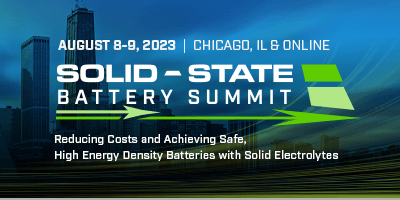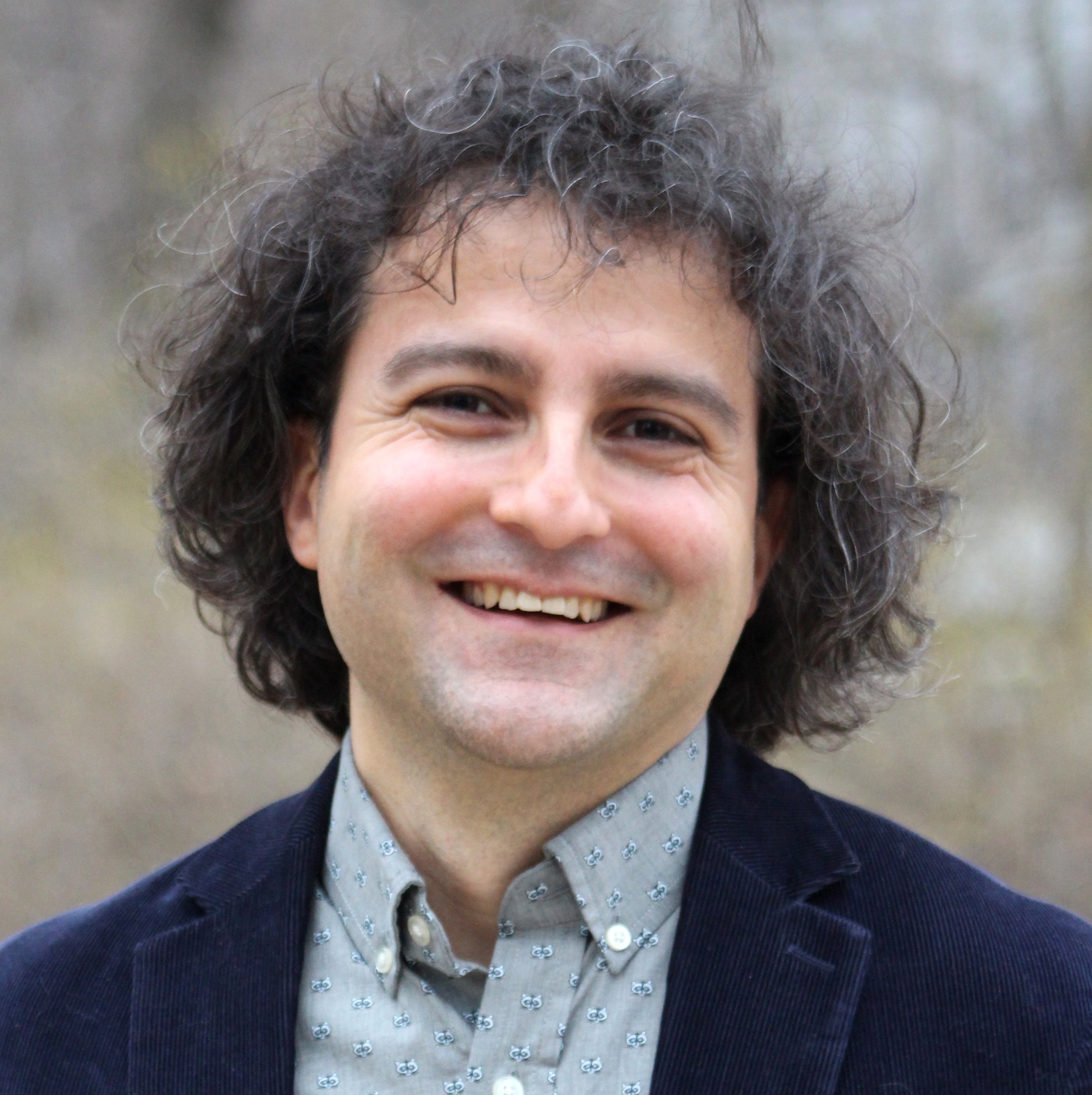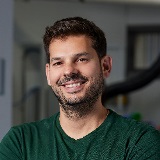Solid-State Battery Summit Virtual
August 3 - 4, 2021 U.S. Eastern Daylight Time
Tuesday, August 3
Craig Wohlers, Executive Director, Conferences, Cambridge EnerTech
Jordi Sastre, PhD, Researcher, EMPA - Swiss Federal Laboratories for Materials Science and Technology
KEYNOTE PRESENTATION
Lithium-metal Solid-State Battery Development at QuantumScape
QuantumScape is developing a solid-state battery with a lithium-metal anode to enable long-range, faster charging, low-cost EVs. This talk will highlight recent developments in solid-state batteries as well as the challenges in commercializing a new battery technology. QuantumScape was founded in 2010 with a mission to revolutionize energy storage to enable a sustainable future.
APPLICATIONS & MARKET
Solid State Batteries Developments, Market and Forecast
We will explore the many developments, announcements and funding approaches that have led to high interest in solid state batteries. This talk will cover the different groups doing developments in solid state batteries and the current progress toward commercialization. Many challenges remain in launching this technology and it being competitive in large format batteries and getting the approvals needed for use in automotive. Market forecasts have been developed by end use application will be covered through 2030.
Solid-State Batteries: The State of Innovation
Solid-state batteries have long been hailed as the “holy grail” of Li-ion batteries. However, over the past year, several major automakers have announced shifts in their battery strategies towards lower-cost technologies, such as lithium-iron-phosphate (LFP) and high-manganese cathodes. This presentation will discuss the current state of innovation for solid-state batteries, automakers’ timelines for incorporating them into a vehicle, and the role that they could play in the broader electric vehicle market. It will also discuss the leading global development partnership networks centered around solid electrolytes and lithium metal anodes, as well as several companies developing cutting-edge technologies for this market.
Challenges and Opportunities for Solid-State Players – Can They Be Competitive on the Battery Market within Automotive Applications?
Increasing battery demand and requirements towards high performance cells are pushing lithium-ion technology to its limits. Recent developments in solid-state technology have led to a high level of media attention, and both start-ups and large cell manufacturers are intensively working on the industrialization of their next-generation technology as major challenge. The competitiveness of currently leading players regarding technology, scalability and costs aspects will be evaluated and discussed in the presentation.
OEM PERSPECTIVES ON SOLID-STATE
Technological Advancements in Solid-State Batteries for Electric Vehicles
The demand for electric vehicles (EVs) is growing exponentially as is the growing need for longer range EVs coupled with improved safety and fast charging capabilities. To date, state-of-the-art Li-ion batteries (SOA LIBs) based on alkali metal ion intercalation cathodes and anodes have been widely adopted in plug-in hybrid and niche high performance electric vehicles. This presentation highlights the need for SSBs and discusses the major challenges faced by solid-state battery technology development in gaining wide-scale market adoption and competitiveness. Furthermore, the practices and principles that have been proposed for dealing with core problems related to SSBs as well as future research avenues that will encourage the adoption of SSBs in real application will be discussed.
Solid-State Batteries for All-Electric Future: Opportunities and Challenges
As the EV industry continues searching for the next-generation battery technology aiming for higher energy density and greater safety, solid-state batteries (SSBs) have received a resurgence of interest across the entire industry as well as the relevant academic fields. This talk will highlight the unique advantages and fundamental challenges of SSBs for foreseeable EV applications on its way to an All-Electric future in GM.
OEM PERSPECTIVES ON SOLID STATE
Steven Visco, PhD, CEO & CTO, PolyPlus Battery
Solid-State Batteries: Present and Future. Perspectives from an Industry Leader.
Blue Solutions has proven to make what most people believe represents the future of advanced battery technology a reality. Two reasons for lack of existence of multiple manufacturers of solid-state batteries are the difficulty to successfully make a commercial product, and the challenge to scale up the manufacturing processes necessary to build the ‘giga-factories’. We review, all-solid-state batteries manufacturing, current applications, and the near future technological path necessary to have solid-state batteries become the de facto technology of use.
ELECTROLYTE INTERFACE STABILITY
Thin-Film Lithium Garnet Electrolytes for Solid-State Batteries
Lithium garnets have come under the spotlight owing to their high Li-ion conductivity and wide electrochemical stability window, making them promising electrolytes for the development of solid-state lithium batteries. Thin film deposition of solid electrolytes allows the fabrication of better SSBs by reducing the thickness of the electrolyte. Thin film architectures can also be useful model systems to investigate interface charge dynamics and serve as playgrounds for interface engineering.
NAVIGATING THE PATHWAY TO DISCOVERY AND COMMERCIALIZATION
 2:00 pmSolid State Battery Technology Breakthrough, Commercialization, and Highlights of ProLogium
2:00 pmSolid State Battery Technology Breakthrough, Commercialization, and Highlights of ProLogiumAs EV demand growing, the industry is seeking the next generation battery and solid state battery is considered the most promising one due to high safety, high energy density and low cost advantages. In this talk, ProLogium will highlight its enabling solid state battery technology progress, competitiveness with peers and the omni solution for commercializing EV application.
Solid-State Materials Discovery: From Prediction to Synthesis
Recent advances in computational materials science allow rapid prediction of new materials with superior properties based on ab-initio methods such as density functional theory (DFT). However, experimental synthesis and testing of predicted compounds presents a major bottleneck in realizing the promise of rational materials design. To address this limitation, we have developed the ASTRAL system, which uses robotic handling to perform automated high-throughput sol-gel synthesis and X-ray diffraction (XRD). By combining combinatorial screening with automated quantitative analysis of XRD, the ASTRAL system can quickly explore a wide range of experimental conditions to maximize the speed of materials discovery.
Remember those times when you would bump into someone at a conference and strike up a conversation? Here we simulate such an environment where you can easily chat with an attendee or jump into a group discussion. Feel free to grab a coffee and join the conversations.
Solid-State Batteries – The Promise vs. Reality
All solid-state battery developers have the same goals of increasing energy density with lower costs and higher performance. The question becomes what targets are achievable, cost-effective and scalable. This expert panel will examine the current realities of solid-state battery development and separate that from the promises to break down what is within reach and what isn’t.
Wednesday, August 4
Craig Wohlers, Executive Director, Conferences, Cambridge EnerTech
KEYNOTE PRESENTATION
Progress toward Automotive Qualification for All Solid-State Batteries in Passenger Electric Vehicles
As the company prepares a formal A Sample cell, which will be larger and higher capacity than the company's current 20Ah cell, Solid Power will discuss key cell improvements that have been realized through roll-to-roll process improvements and give an overview of the automotive qualification process as it relates to the company’s all solid-state cell design.
Josh Buettner-Garrett, CTO, Solid Power, Inc.
CATHODE AND ANODE INTERFACE
A Dynamic Stability Design Strategy for Lithium Metal Solid-State Batteries
Solid-state batteries pose new challenges to the battery design due to the unique solid-solid interfaces at battery cathode and anode. However, these interfaces, upon critical understanding and design, also form the new opportunity to achieve battery performances beyond the current commercial liquid electrolyte batteries. We design the lithium metal anode for solid state batteries based on our unique mechanical constriction principle, making a more stable cycling at high current densities.
High Energy Silicon Anodes for Thiophosphate-Based All-Solid-State-Batteries
Scalable concepts for high energy anodes are presented. The columnar Si-anode exhibits 1D-breathing mechanism similar to lithium, which preserves the interface toward the electrolyte. Stable cycling is demonstrated for more than 200 cycles in full cells. To reduce the stack pressure and anode breathing, we furthermore investigated silicon-carbon void structures with silicon contents of up to 37 wt% in solid state batteries. The carbon matrix enables enhanced performance and lifetime of the Si-C composites at high loadings of 7.4 mAh cm-2. The electrolyte does not penetrate the voidstructure resulting in less side reactions, which eliminates the need for prelithiation.
Remember those times when you would bump into someone at a conference and strike up a conversation? Here we simulate such an environment where you can easily chat with an attendee or jump into a group discussion. Feel free to grab a coffee and join the conversations.
Concentrating on the Cathode – The Cornerstone of Solid-State
Solid-State Battery research is primarily focused on development and utilization of a solid lithium-ion conductive electrolyte and elimination of a non-lithium anode. However, not only will the cathode survive the transition to solid-state, new options open up for its material and structure. For large-format thin-film batteries this is the last frontier, but for all other types of solid-state batteries cathode considerations may provide the differentiation needed for commercial success.
POLYMER-BASED BATTERIES
Improving Polymer-Based Solid-State Batteries
While ceramic electrolytes meet the conductivity requirement for SSB, they do nor presently allow for easy assembling of such batteries. On the other hand, polymer electrolytes do not possess the needed low temperature conductivity. We will show the preparation of of comb polymers with pendent PEO segment, separated by a flexible tether show the highest conductivity today without a plasticizer. In a second part, we study new solutes able to increase the T+ of the electrolyte. Attaching the anion to a cellulose backbone yields T+ ≈ 1 electrolytes. Also, the simple TFSI anion in which one F is replaced by H has a high T+ and provides excellent SEI formation.
HIGH RESOLUTION PRODUCTION ANALYSIS FOR MANUFACTURING
 12:00 pmAssessing Lithium-Ion Battery Cells with 3D X-Ray Inspection
12:00 pmAssessing Lithium-Ion Battery Cells with 3D X-Ray InspectionNew energy battery manufacturers face challenges when trying to non-destructively map the battery electrodes microstructure in 3D, its heterogeneities, and their effect on battery aging and performance. This presentation introduces workflows that combine high-resolution X-ray microscopy and computed tomography to generate detailed internal views of 3D microstructure in rechargeable batteries without destroying them. These workflows can speed up development time, increase cost-effectiveness, and simplify failure analysis and quality inspection of new energy battery cells deliverables.
POSTER PRESENTATIONS
Richard Clark, Global Lead, Energy Storage, Morgan Advanced Materials
Selected poster presentations will be pre-recorded oral presentations. Poster presenters will be available to answer any audience questions in the chat while their poster presentation is being broadcast.
Stabilization of the Cathode-Electrolyte Interface for 5 V-Class All-Solid-State Batteries
A 5 V-class spinel cathode is targeted to combine with a high-ionic-conductivity sulfide solid electrolyte for developing high-performance all-solid-state batteries. Aiming to passivate and stabilize the cathode-electrolyte interface, three oxide materials are rationally applied to decorate the surface of pristine cathode particles with various amounts through a wet-chemistry approach.
Rapid Rate Capability Determination of All-Solid-State Batteries via Chronoamperometry
Rate capability determination is an essential part of battery cell development and characterization. Chronoamperometry is presented as a rapid alternative to the standard rate capability test, while also not being limited to discrete C-rates. The rate performance of three different cathode active materials in an all-solid-state battery is characterized by chronoamperometry and an excellent agreement with the standard rate performance test is demonstrated.
The Origin of Mixed Conductivity in Lithium Lanthanum Titanate (LLTO)
Lithium lanthanum titanium oxide (LLTO) has long been considered a promising candidate for use as solid electrolyte in all-solid-state batteries. However, recent experimental reports indicate LLTO shows electronic as well as ionic conductivity. We use density functional theory to investigate the electronic structure of LLTO and elucidate the conditions under which mixed conductivity occurs. Results indicate that spontaneous Li insertion shifts the band edges, resulting in mixed conductivity.
Scalable Production of Solid-State Batteries Based on Sulfide Solid Electrolytes
Currently, there are many challenges for upscaling synthesis processes of sulfide solid electrolytes (SE) as well as the production of solid-state batteries (SSBs). Thus, our work focuses on gaining a deeper understanding of process-product relations and to evaluate and establish new process strategies for the production of SE as well as SSBs. The presentation gives an overview of the whole process chain and discusses results as well as future challenges.
High-Energy Solid-State Batteries by the Use of Nanostructured Si-C Anode Materials
Silicon-carbon void structures (Si-C) are evaluated as anode material for all-solid-state batteries (ASSBs). The enhanced performance of the Si-C electrodes compared to bare silicon nanoparticles in half-cells indicate the effective compensation of the volume changes of silicon through the carbon matrix. Solid-state full cells comprising the Si-C void anodes show higher initial discharge capacities than the liquid electrolyte full cells. The balancing of full cells is also studied.
Influencing the Microstructure of Composite Solid Polymer and Ceramic Electrode-Particles
All-Solid-State Electrodes promise increased energy densities, fast charging properties and higher safety compared to traditional liquid-based systems. In this study, an additive manufacturing process is intended to produce 3D-structured and graded composite cathodes from composite particles in order to promote ionic and electric conductivity. The overall electrochemical performance is limited by the slowest transport mechanism within the cathode. Therefore, it is important to build up sufficient electrical and ionic conductive pathways and to understand how the process parameters affect the conductive additive distribution.
Thermal Modeling of Liquid Electrolyte in Solid-State Batteries
To overcome interfacial resistance in solid-state batteries, a small amount of liquid electrolyte is often utilized; however, this raises the question of safety impact. That question is explored through thermal modeling. A sample of key findings include: a small enough amount of liquid electrolyte has a nearly negligible effect on heat release and, as energy density improves, heat release due to solid electrolyte failure becomes more consequential.
Developments in Robust Early Detection of Thermal Runaway
Amphenol has developed a family of multiphysics sensors that can monitor the airspace within a battery enclosure to detect the onset of cell thermal runaway from lithium ion cells with various electrochemistries including LFP, NMC, and NCA. The fast response sensor platforms utilize a combination of thermal conductivity and Non dispersive infrared spectroscopy for primary detection, with auxiliary measurements of temperature, relative humidity, and air pressure.
NEW APPROACHES TO SOLID-STATE BATTERY DESIGN
Addressing Challenges of Solid-State Batteries Using High Throughput
Successful demonstration of all solid-state batteries requires combining multiple components, each of which must meet certain performance metrics. In addition, the nature of the interfaces between the components can dominate the cell performance regardless of the properties of the individual components. These complex systems, which need to include cathode/catholyte formulations, solid electrolyte membranes, and lithium metal, can be challenging to investigate experimentally due to the large number of variables. This presentation will show several examples of the power of high throughput methodologies to optimize component properties, address interfacial challenges, and investigate material combinations.
Development of Ultra-Thin Conductive Glass for Next-Generation Batteries
PolyPlus Battery Company is developing next generation lithium metal batteries based on the use of continuous sheets of high conductivity sulfide glass separators. The use of lithium metal as an anode will lead to the highest possible energy density for lithium based chemistries. PolyPlus has a proprietary draw tower installed in its Berkeley facility and has recently produced sulfide glass sheet as thin as 15 microns. The approach is inherently scalable and is expected to reach cost parity with polymeric separators with high volume manufacturing.
Improving Solid-State Battery Performance Through Physics, Not Chemistry
While most efforts to enhance battery performance to date have been focused on battery chemistry, this has only led to incremental changes over the past 30 years. The key to the next step-change in battery performances lies within its structure. In this presentation, Addionics’s CEO Moshiel Biton will discuss his learnings from over 10 years researching and developing battery materials and architecture, and highlight how a new 3D electrode design can solve the multiple challenges that still exist with today’s solid-state batteries: namely the energy-power tradeoff and cost. He can also discuss new approaches to scaling battery manufacturing and how AI can be used to accelerate the adoption of this new electrode design in the battery market.
MANUFACTURING PROCESS INTEGRATION AND SCALABILITY
Micro to Giga Scale: Different Materials, Processes and Challenges
Solid State Batteries are expected to outperform incumbent liquid-based battery technologies thanks to unique safety, energy density and scalability advantages. SSBs have the potential to improve and even enable new application over a wide Wh-level range: from micro-batteries powering Augmented Reality smart contact lenses and perpetual Internet of Things sensors, to pouch cells providing safer and lighter power to cordless domestic devices and longer range to electric vehicles and new aerospace applications. Yet, after a few decades of R&D, the commercialisation of small SSB is only recent and that our larger format pouch cells still around the corner. This presentation will compare and contrast the various challenges and choices of chemistries, processes and engineering solutions necessary for the development of mWh level micro batteries to the full commercialisation of SSB modules at GWh level.
SOLID-STATE BATTERY SAFETY
Safety and Qualification Testing Considerations for Solid-State Batteries
There is a gap between the academic testing of cutting edge battery technologies and the safety testing often performed on commercial li-ion batteries. In this presentation we will discuss what types of tests are typically performed industrially, what their limitations are, and potential considerations as these are applied to solid state cells.






































